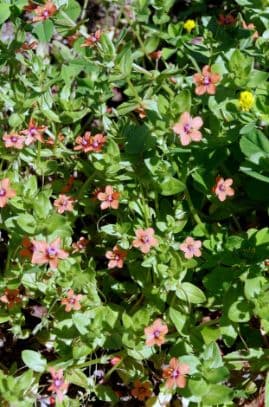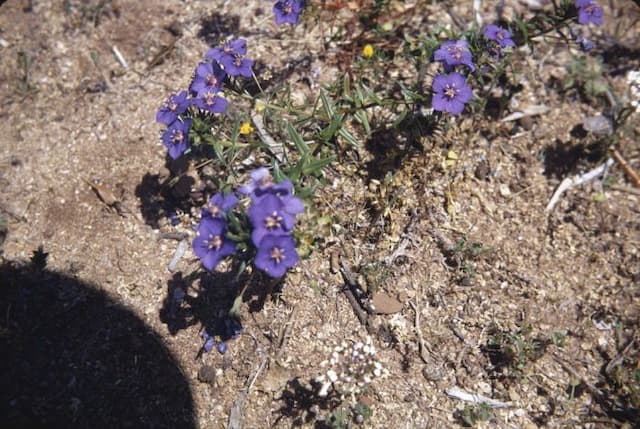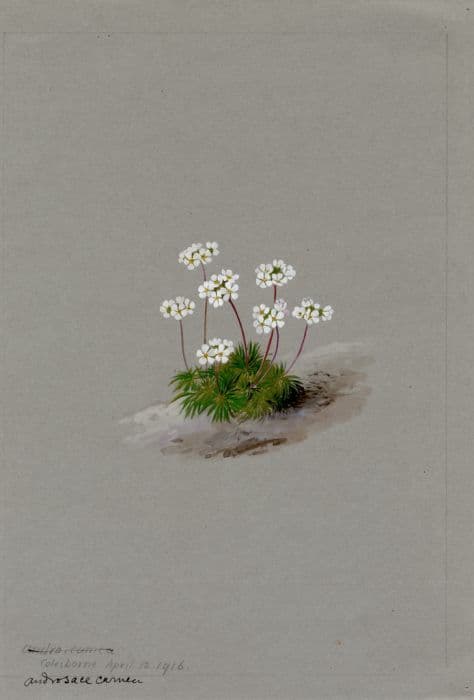Eastern cyclamen Cyclamen coum

ABOUT
The plant known as Cyclamen coum is a perennial herbaceous plant that is often admired for its charming and vibrant display during late winter to early spring. This plant has heart-shaped, dark green leaves which are sometimes patterned with silver markings, creating a lovely contrast and adding to its ornamental appeal. The foliage forms a low-growing, compact rosette. Flowers of the Cyclamen coum are delicate and have a nodding, swept-back appearance. They come in shades of pink, magenta, and sometimes white, each blossom with a distinctive darker color at the base, creating a striking 'eye' effect. The petals are upswept, which gives the blooms an elegant, fairy-like look. The petals can vary in shape, with some being rounded and others more elongated, adding to the diversity of the plant's display. This plant is often noted for the grace it brings to the garden during a time when few other plants are in flower, offering a hopeful splash of color to the late winter landscapes. The blooms and leaves emerge from a tuber that lies dormant underground during the hotter and drier months, bursting into life as the temperatures begin to cool.
About this plant
 Names
NamesFamily
Primulaceae.
Synonyms
Eastern Cyclamen, Winter Cyclamen, Smallflower Cyclamen, Round-leaved Cyclamen, Hardy Cyclamen.
Common names
Cyclamen vernale, Cyclamen caucasicum, Cyclamen cilicium.
 Toxicity
ToxicityTo humans
Eastern sowbread contains saponins, which are toxic substances that can cause poisoning if ingested. These compounds can lead to gastrointestinal irritation, including symptoms such as vomiting, diarrhea, and abdominal pain. Ingestion of significant quantities could lead to more serious effects such as seizures or heart rhythm abnormalities. It is important to handle the plant with care and ensure that it is not consumed by children or adults.
To pets
Eastern sowbread has toxic components that can be harmful to pets if ingested. This plant contains saponins that can cause symptoms such as vomiting, diarrhea, and loss of appetite in pets. In severe cases, ingestion could result in heart problems, seizures or even death. It is crucial to prevent pets from eating any part of the plant to avoid potential toxicity.
 Characteristics
CharacteristicsLife cycle
Perennials
Foliage type
Evergreen
Color of leaves
Varies
Flower color
Varies
Height
4 inches (10 cm)
Spread
6 inches (15 cm)
Plant type
Bulb
Hardiness zones
5
Native area
Mediterranean
Benefits
 General Benefits
General Benefits- Ornamental Appeal: Cyclamen coum, also known as Eastern Sowbread, adds aesthetic value to gardens with its vibrant and colorful flowers, which can range from pink to purple and are often accompanied by a distinctive silver pattern on the leaves.
- Winter Bloom: It flowers during late winter and early spring, providing color during a time when few other plants are in bloom.
- Drought Tolerance: Once established, Eastern Sowbread is relatively drought-tolerant, making it suitable for gardens with less frequent watering.
- Shade Tolerance: This plant can thrive in part to full shade, making it ideal for planting under trees or in shaded corners of the garden.
- Attracts Pollinators: The flowers of Cyclamen coum attract pollinators such as bees, which are beneficial for the garden ecosystem.
- Low Maintenance: It requires minimal maintenance once established, making it a good choice for gardeners of all levels of experience.
- Deer and Rodent Resistance: Cyclamen coum is generally not favored by deer and rodents, reducing the risk of damage from these animals.
- Long-Lived Perennial: Being a perennial, Eastern Sowbread can live for many years, providing long-term interest and value in the garden.
- Ground Cover: Its spreading nature allows it to be used as effective ground cover, which can help prevent soil erosion and suppress weed growth.
- Seasonal Interest: The plant's leaves are often patterned and can remain attractive even when it is not in flower, providing year-round interest in the garden.
 Medical Properties
Medical Properties- This plant is not used for medical purposes.
 Air-purifying Qualities
Air-purifying QualitiesThis plant is not specifically known for air purifying qualities.
 Other Uses
Other Uses- Cyclamen coum tuber decoctions have historically been used for washing clothes, as the saponins in the tuber can act as a gentle soap.
- The tubers can be processed to create a starch-like substance that has been used in some traditional textiles to provide stiffness to fabrics.
- In some cultures, cyclamen is a symbol of love and tenderness; it has been used as a decorative motif in art and artifacts to convey such emotions.
- The leaves and flowers are sometimes used in floral arrangements as they can provide an attractive contrast to other flowers.
- A dye can be extracted from the petals of Cyclamen coum, which is used for coloring textiles or artworks in a pinkish hue.
- Cyclamen seeds contain a substance that is poisonous to fish, and it has been used in some regions as a fish poison for fishing.
- The plant has been incorporated into garden landscapes to attract pollinators like bees, butterflies, and hummingbirds owing to its nectar-rich flowers.
- Cyclamen coum plants are used as a teaching tool in botany and horticulture to demonstrate bulb and tuber propagation and development.
- Its protective properties against erosion make it suitable for planting in areas that are prone to soil degradation, helping to stabilize the ground with its root system.
- In folklore, cyclamen was believed to have protective qualities and was planted near homes or carried as an amulet to ward off evil or misfortune.
Interesting Facts
 Feng Shui
Feng ShuiThe Cyclamen is not used in Feng Shui practice.
 Zodiac Sign Compitability
Zodiac Sign CompitabilityThe Cyclamen is not used in astrology practice.
 Plant Symbolism
Plant Symbolism- Deep Love: Cyclamen, sometimes known as Persian Violet, often symbolizes deep, lasting love, due to its heart-shaped leaves and lasting nature.
- Resignation and Goodbye: In the language of flowers, gifting Cyclamen can mean a parting of ways or resignation, signaling a respectful end to a relationship.
- Sincerity and Devotion: The Cyclamen's tendency to grow from a tuberous base which survives for many years can represent sincerity and devotion in relationships.
 Water
WaterCyclamen coum, commonly known as Eastern Cyclamen, prefers to be watered when the top inch of soil feels dry. Generally, this means watering it approximately once a week, but this can vary depending on environmental conditions such as temperature and humidity. It is important to water the plant thoroughly, providing enough water so that it reaches the roots without waterlogging the soil. A good practice is to add water until it begins to drip from the drainage holes, which might be around 16-24 ounces for a standard indoor pot. During its dormant period in the summer, reduce watering significantly to prevent tuber rot.
 Light
LightEastern Cyclamen thrives in bright, indirect light, which makes an east-facing window that gets morning sun an ideal spot for this plant. They can also adjust to low-light conditions, but their flowering might be reduced. Avoid placing Eastern Cyclamen in direct, harsh sunlight, as this can cause leaf burn and affect the plant's overall health.
 Temperature
TemperatureThe Eastern Cyclamen enjoys cooler temperatures and performs best between 60 to 68 degrees Fahrenheit. However, it can tolerate temperatures as low as the mid-40s and as high as the low 70s. Keeping the plant at its ideal temperature range will encourage better flowering and overall health. Protect the plant from sudden temperature changes and drafts, which can induce shock.
 Pruning
PruningPruning Eastern Cyclamen is primarily done to remove yellowing or dead leaves and spent flowers, which encourages new growth and helps maintain a tidy appearance. It is best to prune right after the blooming period has ended, typically by gently pulling the spent flowers and leaves away from the base to avoid damaging the tuber. Regular removal of spent blooms and foliage can be done throughout the flowering season.
 Cleaning
CleaningAs needed
 Soil
SoilThe best soil mix for Eastern Sowbread (Cyclamen coum) is one that is well-draining and humus-rich, with a pH of around 5.5 to 7. It can be made of equal parts potting soil, peat moss, and perlite to ensure good drainage and aeration. Adding a layer of gravel at the bottom can also promote better drainage to avoid waterlogged conditions.
 Repotting
RepottingEastern Sowbread should be repotted every 1-2 years, ideally in the fall, after the flowering period has ended. It's important to choose a pot slightly larger than the current one since Cyclamen coum prefers a snug fit, and make sure that the tuber is planted with the top half exposed.
 Humidity & Misting
Humidity & MistingEastern Sowbread thrives best in moderate to high humidity levels. It's ideal to maintain the humidity around 50-70%, which can be achieved through regular misting or placing a tray with water and pebbles beneath the pot to increase the moisture in the air. Avoid excessively dry air, especially during winter when indoor heating can reduce humidity.
 Suitable locations
Suitable locationsIndoor
Place in bright, indirect light and keep in cool room.
Outdoor
Plant in dappled shade, shelter from extreme weather.
Hardiness zone
5-9 USDA
 Life cycle
Life cycleCyclamen coum, commonly known as Eastern cyclamen, begins its life cycle from a tuber, which sprouts in autumn, producing heart-shaped leaves and sometimes flowers at this time. The flowers bloom typically in late winter to early spring, exhibiting petals that range in color from white to deep pink with a magenta blotch at the base. After pollination, which is mainly facilitated by bees, the flower stems coil, bringing the developing seed pods closer to the ground. Once the seeds ripen by late spring or early summer, the foliage dies back, and the plant enters a period of dormancy during the hot summer months. During dormancy, the tuber persists underground, conserving energy for the next growing season. With the arrival of cooler temperatures in autumn, the cycle resumes as the tuber sends up new leaves, starting the process anew.
 Propogation
PropogationPropogation time
Late winter-early spring
The most popular method of propagating the Eastern sowbread is by seed. It includes collecting seeds from the ripe pods of the plant after the flowering season, which usually ends in early spring. Once collected, sow the seeds immediately as their viability decreases rapidly with time. It's important to place them on the surface of a well-draining potting mix and just lightly press them into the soil, as they need light to germinate. Cover them with a light layer of fine grit or perlite to keep them moist. The germination can be slow and erratic, taking from a few weeks up to several months, and it's optimal to maintain temperatures of about 65°F (18°C). Once the seedlings develop a couple of true leaves, they can be carefully potted on into their individual pots.









